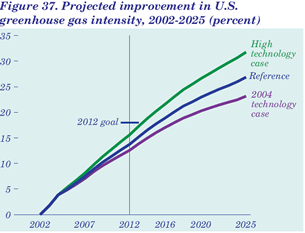|
Issues in Focus U.S. Greenhouse Gas Intensity On February 14, 2002, President Bush announced the Administration’s Global Climate Change Initiative [99]. A key goal of the Climate Change Initiative is to reduce U.S. greenhouse gas intensity by 18 percent over the 2002 to 2012 time frame. For the purposes of the initiative, greenhouse gas intensity is defined as the ratio of total U.S. greenhouse gas emissions to economic output. AEO2004 projects energy-related carbon dioxide emissions, which represented approximately 83 percent of total U.S. greenhouse gas emissions in 2002. Projections for other greenhouse gases are based on projected rates of growth in their emissions, published in the U.S. Department of State’s Climate Action Report 2002 [100]. Table 19 combines the AEO2004 reference case projections for energy-related carbon dioxide emissions with the projections for other greenhouse gases. According to the combined emissions projections in Table 19, the greenhouse gas intensity of the U.S. economy is expected to decline by nearly 14 percent between 2002 and 2012, and by 27 percent between 2002 and 2025. The Administration’s goal of reducing greenhouse gas intensity by 18 percent by 2012 would require additional emissions reductions of about 394 million metric tons carbon dioxide equivalent. Although AEO2004 does not include cases that specifically address alternative assumptions about greenhouse gas intensity, the integrated high technology case does give some indication of the feasibility of meeting the 18-percent reduction target. In the integrated high technology case, which combines the high technology cases for the residential, commercial, industrial, transportation, and electric power sectors,carbon dioxide emissions in 2012 are projected to be 175 million metric tons less than in the AEO2004 reference case. As a result, U.S. greenhouse gas intensity would fall by almost 16 percent over the 2002-2012 period, still somewhat short of the Administration’s goal of 18 percent (Figure 37). An 18-percent decline in intensity is projected to occur by 2014 in the integrated high technology case, as compared with 2016 in the reference case.
Released: January 2004 |
| |||||||||||||||||||||||||||||||||||||||||||||||||||||||||||||||||||||||||||||||||||||||

